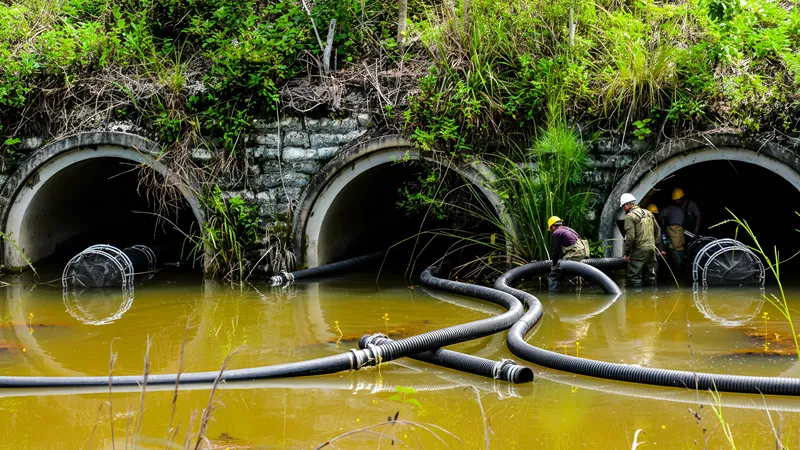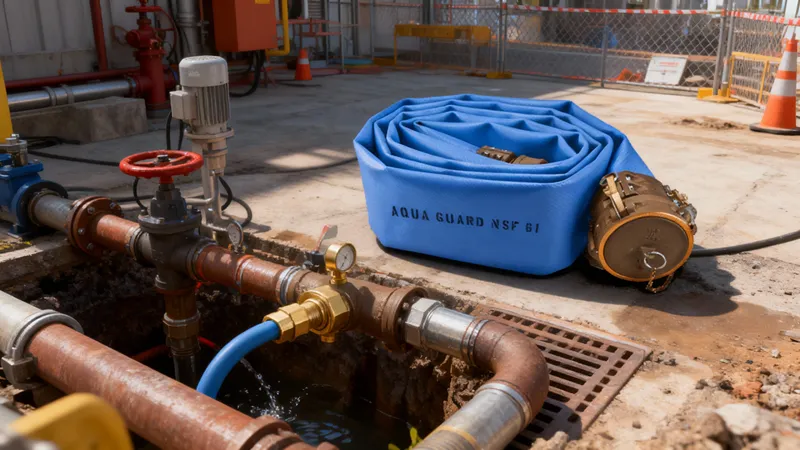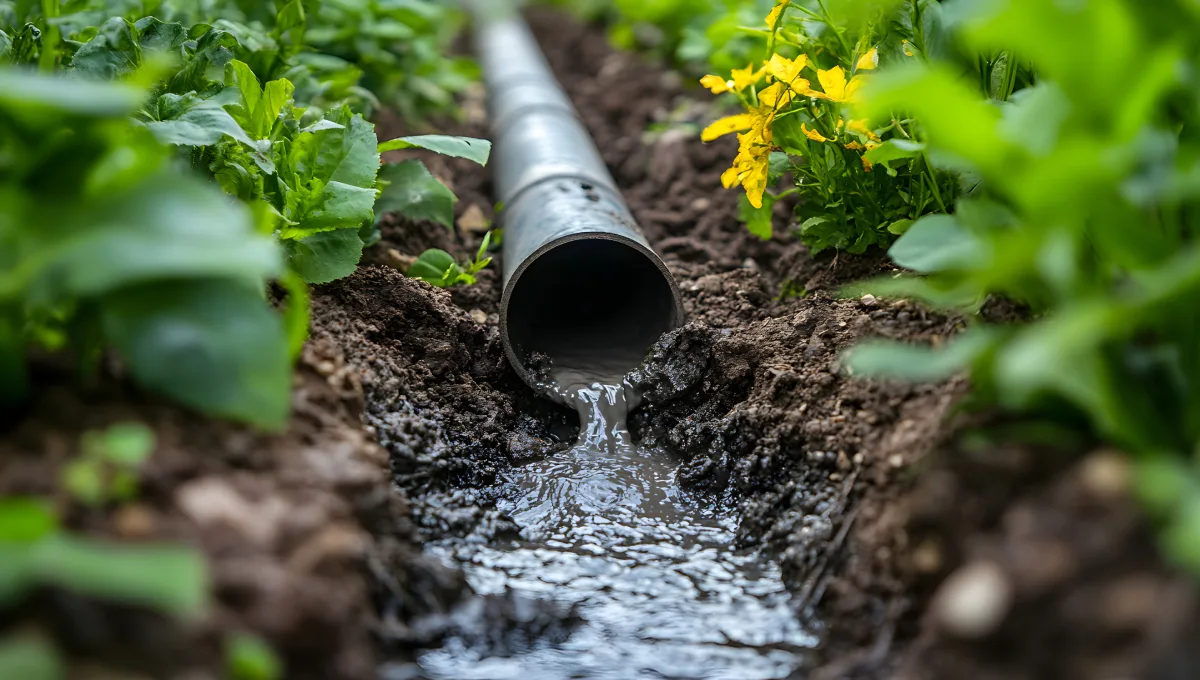Environmental Management: Lay Flat Hose, HDPE Pipe & Slurry Hose
Anaconda designs and supplies industrial hose and piping solutions engineered to meet the performance requirements of the environmental industry. Our lay flat hoses, HDPE pipes, and slurry hoses are engineered to manage the transfer, containment, and recovery of fluids in environmental remediation, wastewater control, and pollution response projects. Built for long service life, chemical resistance, and operational reliability, these systems deliver consistent results in both temporary and permanent field installations.

Home
Lay Flat Hose
EnvironmentalPurpose-Built for Environmental Operations
Effective environmental management relies on dependable equipment that ensures safe, compliant, and efficient handling of contaminated or recovered fluids. Anaconda’s integrated systems, comprising environmental remediation hoses, HDPE piping, provide the mechanical strength, flexibility, and chemical compatibility required in demanding site conditions. Each product is designed for rapid deployment, low maintenance, and compatibility with standard environmental cleanup equipment.

Core Components & Their Environmental Role

Lay Flat Hose
The industrial lay flat hose from Anaconda is engineered for rapid deployment and high-volume fluid handling in environmental remediation settings. Its flat, rollable design allows flexible installation across uneven terrain and simplifies logistics. The hose resists UV radiation and chemical exposure common in cleanup sites, and features a high burst pressure rating, making it reliable during dewatering, contaminated water transfer, or spill-response operations.

HDPE Pipe
Anaconda’s HDPE pipe system delivers a sturdy, long-term solution for fluid conveyance in environmental management. With corrosion-resistant polyethylene construction and leak-free joints, the pipe is suitable for permanent installations such as leachate collection, wastewater discharge, and groundwater transport. Its modular couplings (such as Bauer fittings) reduce assembly time and minimize failure points in field pipelines.


Slurry Hose
Engineered for high-abrasion and heavy-duty fluid transfer. Anaconda’s Slurry Hose is ideal for environmental cleanup and dredging operations. Its reinforced construction withstands the impact of solid particles, chemicals, and fluctuating pressure during sludge removal or contaminated material transport. These hoses complement Lay Flat Hoses and HDPE Pipes, which offer remarkable performance in slurry pumping, residue relocation, and industrial waste management.
Product Comparison: Environmental Hose & Piping Solutions
Feature / Parameter | Lay Flat Hose | HDPE Pipe | Slurry Hose |
|---|---|---|---|
Primary Function | Flexible hose for rapid fluid transfer and dewatering | Rigid piping system for long-term environmental installations | Heavy-duty hose for slurry, sludge, and abrasive fluid transfer |
Pressure Handling | High burst pressure for dynamic pumping. | Consistent pressure performance for continuous flow | Synthetic rubber with textile or steel reinforcement. |
Mobility & Storage | Compact and easy to roll or transport | Semi-permanent; requires mechanical handling | Lightweight and modular; quick assembly |
Installation Time | Fast deployment; minimal tools required | Moderate; involves joint welding or couplings | Quick clip-on or bolt-on attachment |
Environmental Use Case | Groundwater remediation, dewatering, spill response | Leachate collection, wastewater conveyance, and permanent remediation lines | Pond dewatering, surface pipeline support, and dredging operations |
Maintenance | Easy cleaning and replacement | Low; resistant to scale and abrasion | Minimal; periodic inspection recommended |
Best Suited For | Temporary fluid transfer and rapid remediation response | Permanent or semi-permanent environmental systems | Slurry, sludge, and sediment removal in cleanup sites |

Key Performance Advantages
- Chemical Compatibility: Resistant to oils, acids, and industrial contaminants common in remediation and cleanup operations.
- High Burst Pressure: Reliable performance under surge and pulsation conditions during pumping or bypass operations.
- Field Efficiency: Lightweight and flexible construction enables fast deployment and recovery.
- UV and Abrasion Resistance: Designed for extended outdoor exposure and heavy-duty site handling.
- System Integration: Seamlessly connects with existing pumps, valves, and fittings for complete environmental piping solutions.
- Minimal Maintenance: Smooth internal bore reduces friction loss and minimizes clogging.
- Reusability: Long service life reduces replacement frequency and overall operational costs.


Operational Use Cases
- Groundwater and Soil Remediation: Transfer of contaminated liquids and recovery fluids in treatment systems.
- Sediment and Sludge Control: Transport of high-solid slurry using environmental cleanup hoses.
- Wastewater and Effluent Management: Handling of process and stormwater in temporary or permanent setups.
- Pollution and Spill Response: Quick deployment of hoses for containment and bypass flow.
- Landfill Leachate Collection: Continuous drainage and controlled transport of leachate through HDPE piping systems.
- Sargassum removal and coastal cleanup: Facilitates pumping and transfer of sargassum biomass and saline water in coastal remediation.
- Pond and lagoon sludge removal: Handles sediment, sludge, and waste buildup during pond and lagoon maintenance.
Case study
Groundwater Remediation Using Anaconda Hose Systems

Objective:
To establish a reliable and flexible fluid transfer network for contaminated groundwater transport to treatment units across uneven terrain.

Challenge:
Rigid pipeline systems were difficult to deploy and relocate during phased cleanup operations. The client required a mobile, durable, and leak-resistant setup suitable for long-term remediation use.


Solution:
Anaconda supplied an integrated environmental remediation hose system consisting of:
- Lay Flat Hoses for quick deployment and compact storage.
- HDPE Pipes provide chemical resistance and long-distance durability.

Results:
- 40% faster installation and relocation compared to rigid pipes.
- Zero leakage incidents during continuous operation.
- Stable, sturdy setup in variable terrain conditions.
- Full compliance with environmental remediation standards.


Outcome:
A remediation contractor used Anaconda’s Lay Flat Hose, HDPE Pipe, and Slurry Hose to pump contaminated sediment from dewatering pits to treatment tanks. The slurry hose handled abrasive material efficiently, while the HDPE pipeline provided a stable backbone for long-distance transfer. The system reduced downtime, ensured leak-free operation, and improved cleanup efficiency by 35%.
Frequently Asked Questions
What makes Anaconda’s Lay Flat Hoses suitable for environmental applications?
Anaconda’s lay flat hoses are engineered for high-pressure fluid transfer and dewatering operations in environmental projects. Their flexible design allows easy deployment across uneven terrain, while their chemical and UV resistance ensures safe transport of contaminated water and remediation fluids without leakage or degradation.
How do HDPE Pipes contribute to sustainable environmental management?
HDPE pipes offer a corrosion-free and leak-resistant solution for long-term environmental fluid transport. Their high chemical resistance makes them ideal for groundwater remediation, wastewater conveyance, and landfill leachate systems. The durability and recyclability of HDPE also align with modern sustainability and compliance standards.
Can Lay Flat Hoses and HDPE Pipes be integrated into a single remediation system?
Yes. Many environmental remediation hose systems use a combination of lay flat hoses for temporary connections and HDPE pipes for fixed sections. This hybrid setup allows flexibility, quick setup, and reliable long-term performance while maintaining flow consistency and pressure balance.
What pressure ratings are available for Lay Flat Hoses?
Anaconda’s industrial lay flat hoses for environmental use are available in various pressure ratings, typically ranging from 150 PSI to 300 PSI. The correct selection depends on the pumping capacity, fluid type, and site conditions.
Are these hoses compatible with common coupling systems?
Yes. Both lay flat hoses and HDPE pipes are compatible with industry-standard fittings, such as Bauer, Camlock, or Storz couplings. This ensures quick connection, secure sealing, and interchangeability across different environmental cleanup equipment.
What are the storage and handling advantages of Lay Flat Hoses?
The compact storage hose for environmental use can be easily rolled, transported, and redeployed, reducing space requirements and logistics costs. This is especially useful for mobile remediation units and emergency cleanup operations where speed and portability are critical.
Are these products compliant with environmental regulations?
Yes. All environmental pipe and hose equipment from Anaconda is designed to meet or exceed EPA and other regional environmental standards. The materials are non-toxic, chemically stable, and suitable for use in regulated remediation and cleanup sites.
What types of fluids can be transported using these environmental piping solutions?
Anaconda’s environmental piping solutions are designed to handle a wide spectrum of fluids, from clean and reclaimed water to contaminated slurries, industrial effluents, and chemical-laden waste streams. The Lay Flat Hose manages high-volume water transfer, the HDPE Pipe provides secure and durable long-distance transport, and the Slurry Hose is ideal for abrasive or semi-solid materials. Together, they ensure safe, compliant, and efficient handling of fluids involved in environmental remediation, wastewater management, and pollution control.
How do these products contribute to sustainability in environmental management?
By enabling efficient resource recovery, waste containment, and spill mitigation, Anaconda’s hose and pipe systems directly support sustainability initiatives. The use of recyclable materials like HDPE, combined with durable, long-life hose constructions, reduces material waste and replacement frequency. Moreover, leak-proof connections and reliable flow performance minimize environmental contamination during cleanup and transport activities.
How does Anaconda ensure compatibility between different hose and pipe types?
Anaconda uses a standardized connection and coupling design across its product range. This ensures seamless integration between Lay Flat Hoses, HDPE Pipes, and Slurry Hoses without leakage or performance loss. The engineering team also assists in designing custom fittings for specific applications, providing a unified and efficient fluid transport system for environmental projects.


 (619) 201-8311
(619) 201-8311